Vignettes
for Instruction 
Vignette 1: Fostering Functional Language in CLB 3 LINC
Last fall, I was teaching a group of CLB 3 learners who were brand-new to Canada. My goal was to make sure that everything I did in the class was directly relevant to their real-life needs. I also wanted them to gain as much functional language as possible to speed up their ability to communicate. They needed to be able to talk to their children’s teachers. They wanted to be able to order food. Then winter hit, and they needed language to talk about and find winter clothing.
To help with learning functional language, I created Quizlets of vocabulary, but I had audios of functional language. For instance, a Quizlet with winter clothing had audios of someone saying “Hi, I’m looking for __” and the item pictured and written on the Quizlet (e.g., gloves, winter boots, scarf). Another Quizlet had pictures of clothing that was too big, too small, too tight, etc., and audios saying “I think this is too ___.” A Quizlet with fast foods pictured had audios of someone saying “Hi, I’d like to order ___” and the item pictured (a coffee, a burger, fries, etc.). A Quizlet about school messages had vocabulary such as “absent,” “late,” “leave early,” “not feeling well,” “doctor’s appointment,” etc. The audios said something like “Hello, I’m Sam’s mom. Sam will be absent today.” or “Hello, I’m Sam’s dad. Sam has a doctor’s appointment today.”
Students learned the vocabulary as they used the flashcards, learn, matching, and test Quizlet functions. They practiced sounding out and writing the words. At home and on the bus, they listened over and over to the functional language in the audios. As we role-played interactions in class, they used both the functional language and the vocabulary. In one activity, students sat in pairs, with one person facing the board and the other person facing away from the board. I would project a Quizlet picture or word (“gloves,” “burger,” “absent”), and the student facing the board would say “Hi, I’m looking for…” or “Hello, I’d like to order a…” or “I’m Sam’s mom. He will be…” and the other student would check their comprehension “gloves?” “a burger?” “absent?” and point to the item on a Quizlet printout. After a lot of practice and scaffolding, these real-life tasks became listening and speaking PBLA tasks that learners carried out to demonstrate progress.
Vignette 2: Integrating the 4 Skills in an Employment-focused CLB 3/4 Class
Teaching employment-related English for CLB 3 and 4 students can be quite challenging. To ensure that students achieve their learning goals, I provide them with ample opportunity to practice their listening, speaking, reading, and writing skills.
In one of my units, students develop their phone skills. First, they listen to sample phone calls from the LINC 3 audio files (e.g., Can I Take a Message? and Friendly Phone Conversation). Students listen to identify polite expressions and tone of voice. The audios are replayed 2–3 times and students write down details from each audio sample. Afterwards, they receive feedback on the details they captured. Then, students read a vocabulary chart containing phrasal verbs. They complete a worksheet on the meaning and usage of commonly used phrasal verbs related to phone calls ( e.g. “hold on,” “speak up,” “cut off,” etc.).
After this, students work with a partner and role-play phone conversations following the patterns they heard in the LINC 3 audios and using the phrasal verbs they learned. They demonstrate their role-plays for the class. This speaking activity builds students’ confidence as they communicate with their classmates.
 To reinforce what they have learned, I assign homework where students use a template to plan sample phone conversations with their doctors, dentists, counsellors, teachers, and many others. They write down the details they will need when making mock phone appointments with their classmates. Later, in class, students complete the same templates as they role-play the conversations with their classmates.
To reinforce what they have learned, I assign homework where students use a template to plan sample phone conversations with their doctors, dentists, counsellors, teachers, and many others. They write down the details they will need when making mock phone appointments with their classmates. Later, in class, students complete the same templates as they role-play the conversations with their classmates.
With all of this practice, my CLB 3–4 learners gain confidence in their listening and speaking skills, expand their vocabulary, and develop familiarity with reading and completing simple forms.
Vignette 3: A Grammar Routine
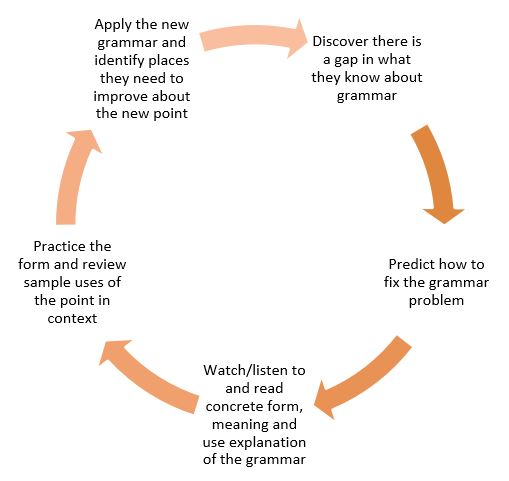
This year I have been trying a new routine that seems to be working for my grammar instruction. During the week I collect sentence errors that my learners commonly make. If my textbook treats a grammar point, I especially try to collect a few errors related to the point in the text.
On Mondays, I present 5 sentences for error correction taken from a variety of anonymous learners. I break the learners into teams of 4, and I give each group the set of 5 sentences that have classic grammar errors. The teams work together to try to correct the sentences. After 10–15 minutes, I hand out a second sheet with hints for each of the 5 sentences, and learners have some time to apply the hints and adjust their corrections. Each group then presents their corrections on one sentence, and we discuss why these choices were made. After the discussion is over, I provide an answer key for their future reference.
For homework that night, I ask the students to read and review form, meaning, and use explanations related to one of the error sentences. I always provide a video and a written explanation because students seem to prefer one or the other. EngVid grammar videos and University of Victoria’s studyzone have been really good for my learners. I also have learners complete online activities with immediate feedback; I’ve found some great focus-on-form activities at Live Worksheets and British Council’s Learn English Teens.
During the week that follows, we look for sample sentences in the textbook readings and in YouGlish. I use these to create cloze and fill-in-the-blank activities (very easy to do with H5P!). Near the end of the week we get into groups and write example sentences related to the topic of the week (often done as part of a prewriting/outlining activity).
Over the weekend the students do their formal writing assignment, and then on Mondays we repeat the cycle with a new grammar point. I integrate a couple of sentences that review the points we studied earlier. By the end of the term, we have recycled the grammar often enough that they seem to understand the form, meaning, and use of target structures, even if they still make small mistakes.
The sample slides below are from my CLB 7 class, but I think you could use this routine for CLB 3+ so long as the sentences are level-appropriate, and the grammar explanations are simple and easy to access.
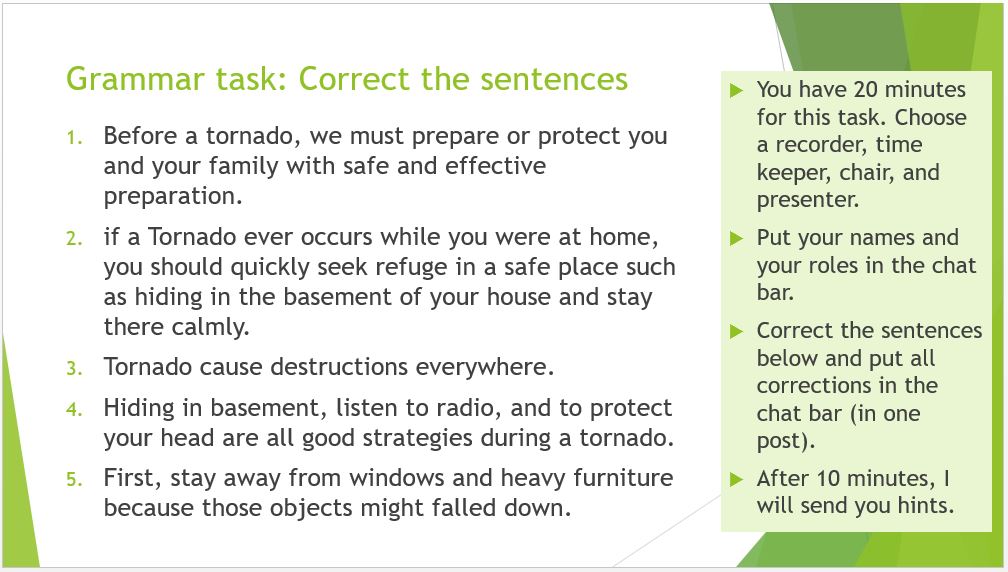
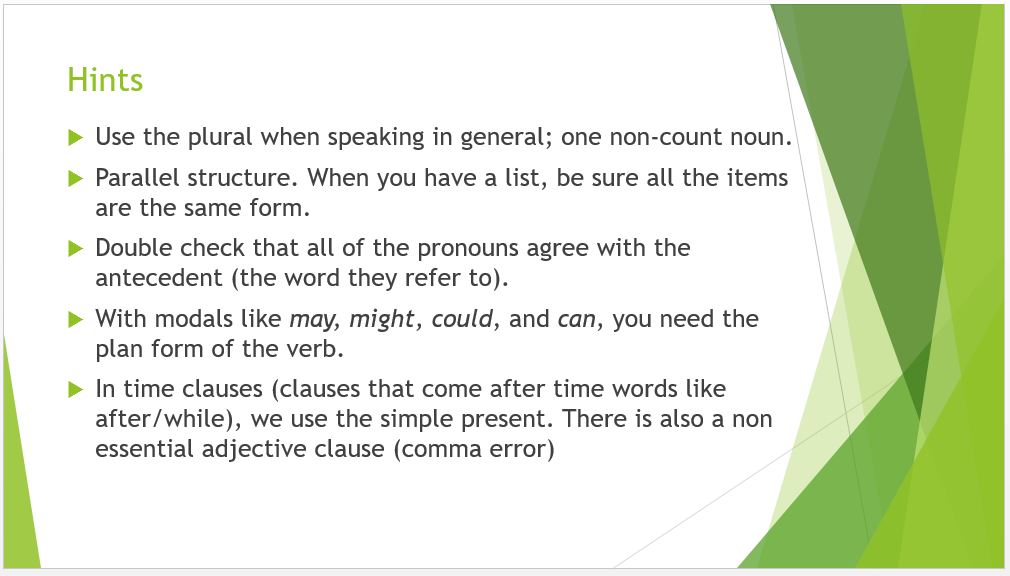
Answer Key:
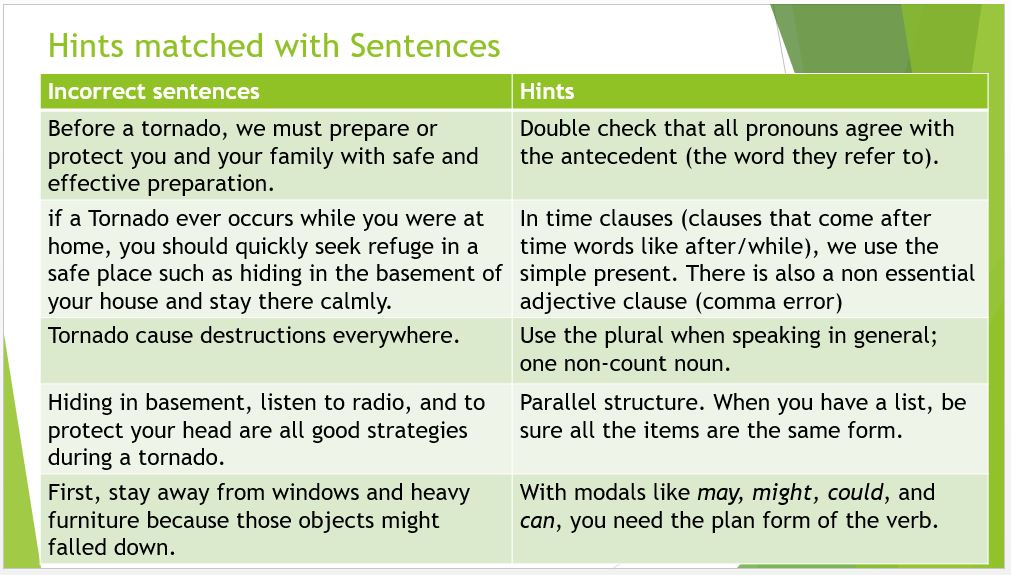
Vignette 4: Integrating Pronunciation
I teach pronunciation remedially and in a targeted manner in almost all my classes. I also train teachers in pronunciation. I have found that most communication issues that occur in my classes are not based on content or meaning but rather on mode of communication. How a misunderstanding is approached or resolved can also be problematic depending on pronunciation issues. In many cases, pronunciation is the primary root of the problem. One ESL class that I was teaching was made up of two predominant language groups: Polish and Urdu speakers. The attitudes and atmosphere in the classroom were rocky in the beginning. There were a lot of misunderstandings based on pronunciation issues. The Eastern Europeans came across as bored and indifferent, while the South Asian speakers were perceived as arrogant and aggressive—neither of which was the intended meaning. I quickly addressed the situation, realizing that the issues were based on word focus and intonation. I did the following:
- We started by looking at thought groups. I provided a couple of examples careful to emphasize the focus word: “Melica is standing.” “I love teaching.” “It’s raining today.” Students generated examples as a class, which I wrote on the board.
- Then, we looked at the main word of each thought group and underlined the stressed syllable within each thought group, depending on the context of the statement. I gave the students a rubber band to use to show the focus word in each thought group by extending the rubber band on the stressed syllable of the focus word.
Melica is standing. I love teaching. It’s raining today.
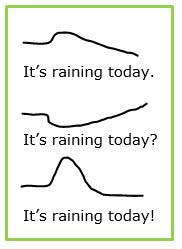
- Next, I drew the intonation contours over each thought group, showing how in English we rise on the stressed syllable of the focus word and then fall gently and not sharply. I also mimicked intonation patterns that had been used in the class to show how perceptions can convey different meanings in English, focusing on aggressive and indifferent patterns in English. I emphasized that while these are the perceptions in English, in other languages they may be seen as normal. The key is to be aware of the message being relayed when transferring L1 intonation patterns to English because they may not convey the intended meaning and may, therefore, result in miscommunication.
- We practiced using the thought groups generated on the board at the beginning of the class and manipulated the focus words to show how the meaning can change. I also provided the following sentences to show how this can change the meaning and the knee-jerk, reflexive perceptions that are conveyed.
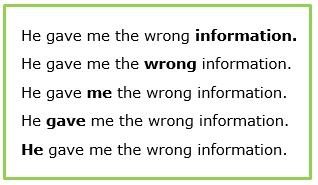
- We practiced controlled dialogues asking for clarification in situations that arise from miscommunication.
- Lastly, we practiced role-plays, focusing on fluency, with similar situations as in #5, emphasizing language and strategies that can be used to diffuse difficult situations.
Language that is used to perform different functions such as apologizing, greeting, giving advice, refusing requests, etc. Functional language often consists of formulaic sequences (fixed combinations of words that are retrieved and used as if they are single words).
Providing support and guidance to enable learners to learn new skills and accomplish tasks. Scaffolding may include things like modelling, vocabulary development, outlines, word lists, templates, planning time, targeted instruction to mitigate anticipated challenges, checklists, etc.

